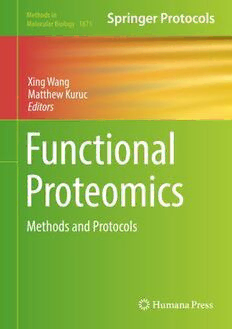Table Of ContentMethods in
Molecular Biology 1871
Xing Wang
Matthew Kuruc
Editors
Functional
Proteomics
Methods and Protocols
M M B
ETHODS IN OLECULAR IO LO GY
SeriesEditor
JohnM.Walker
School of Lifeand MedicalSciences
University ofHertfordshire
Hatfield, Hertfordshire,AL109AB,UK
Forfurther volumes:
http://www.springer.com/series/7651
Functional Proteomics
Methods and Protocols
Edited by
Xing Wang
Array Bridge Inc., St. Louis, MO, USA
Matthew Kuruc
Biotech Support Group LLC, Monmouth Junction, NJ, USA
Editors
XingWang MatthewKuruc
ArrayBridgeInc. BiotechSupportGroupLLC
St.Louis,MO,USA MonmouthJunction,NJ,USA
ISSN1064-3745 ISSN1940-6029 (electronic)
MethodsinMolecularBiology
ISBN978-1-4939-8813-6 ISBN978-1-4939-8814-3 (eBook)
https://doi.org/10.1007/978-1-4939-8814-3
LibraryofCongressControlNumber:2018957271
©SpringerScience+BusinessMedia,LLC,partofSpringerNature2019
Thisworkissubjecttocopyright.AllrightsarereservedbythePublisher,whetherthewholeorpartofthematerialis
concerned,specificallytherightsoftranslation,reprinting,reuseofillustrations,recitation,broadcasting,reproduction
onmicrofilmsorinanyotherphysicalway,andtransmissionorinformationstorageandretrieval,electronicadaptation,
computersoftware,orbysimilarordissimilarmethodologynowknownorhereafterdeveloped.
Theuseofgeneraldescriptivenames,registerednames,trademarks,servicemarks,etc.inthispublicationdoesnotimply,
evenintheabsenceofaspecificstatement,thatsuchnamesareexemptfromtherelevantprotectivelawsandregulations
andthereforefreeforgeneraluse.
Thepublisher,theauthors,andtheeditorsaresafetoassumethattheadviceandinformationinthisbookarebelievedto
betrueandaccurateatthedateofpublication.Neitherthepublishernortheauthorsortheeditorsgiveawarranty,
expressorimplied,withrespecttothematerialcontainedhereinorforanyerrorsoromissionsthatmayhavebeenmade.
Thepublisherremainsneutralwithregardtojurisdictionalclaimsinpublishedmapsandinstitutionalaffiliations.
This Humana Press imprint is published by the registered company Springer Science+Business Media, LLC, part of
SpringerNature.
Theregisteredcompanyaddressis:233SpringStreet,NewYork,NY10013,U.S.A.
Preface
Over thepasttwodecades,tremendousprogresshasbeenmadeinthefieldofproteomics,
thepurposeofwhichistofindsystemicdifferencesinproteinpopulations.Onceestablished,
measurableproteinmarkerscanthenhelptodefinebiologicalmechanism,disease,identify
therapeutictargets,andofferbetterprecisionforpersonalizedmedicalinterventions.
Proteomics, like other “omics” analyses, is data driven and can generate unbiased
proteinprofilesforavarietyofendpointsthatcancontrast,forexample,treatedvs.untreated
cellmodelsorhealthyvs.diseasedtissue;ithasprovideduswithmorein-depthunderstanding
ofmanybiologicalsystemsanddiseases.Thisprogressinthefieldofproteomicsparallelswith
theadvancementinmanyanalytical technologies, especiallyinmassspectrometry,whichhas
beenevolvedfromalesssensitiveandqualitativetooltohighsensitivityandquantitationsystem
forproteinanalysisandcharacterization.Currently,systembiologyandproteomicsinparticular
are advancing biology at two opposite but equally important polarities; one is the holistic
understandingofabiologicalsystem,beitanorganism,organ,tissue,orthehumancirculation
system, and the other one is for single-cell analysis whereby biological heterogeneity can be
minimizedandamorediscretepictureofbiologicalprocessescanbemodeledwithinamore
homogeneous context. Having the tools and methods necessary to address these important
studies will promote the significant impact that is foreseen in precision medicine and other
biologicalfields.
In the most common view of proteomics, data is generally acquired after proteolytic
processingoftheparentproteomes.Thederivedpeptidesarethenanalyzedoninstruments
couplingNano-LiquidChromatographytoMassSpectrometry(LC-MS).Suchinstruments
generate mass spectra of peptides and the MS2 spectra through further fragmentation,
which can be compared to theoretical amino acid spectra definable through public gene
repositories. Peptide sequence matches are thus computationally derived, and from that
data,proteinidentificationsareinferred.Fromsuchanalyses,peptidemarkerscanbeusedas
surrogatesfor thegeneproductsfromwhichtheyarederived.Throughdifferentialexpres-
sionanalysisofthesepeptidemarkers,proteomicscanthushelpidentifythosegeneproducts
that define a phenotype. However the functions of the proteome, the driving force for
almost all biological actions, are not adequately annotated through the current infrastruc-
tureofmethodssurroundingLC-MSsequenceannotation.Thisbookisintendedto fillin
thisknowledgeandtechnologygapwithaspecificcollectionoftechnologiesthathavebeen
developedforthestudyofproteinfunctionataproteomescale.Inorganizingthecontentof
this book, the following points were taken into consideration: (1) It should bridge the
understanding of biology from protein functions to other aspects of protein analysis,
especially in post-translational modification, as most cellular proteins use this mechanism
tocarryouttheiruniqueroleincellularregulation.(2)Thebookshouldalsoactasabridge
tootherlevelsofsystembiologyresearchincludinggenomicsandmetabolomics,sothatthe
readerswillgainarelativelycompletepictureofhowonemightstudythebiologicalsystem
of their interest. (3) Technologies are categorized toward different aspects of protein
functional analysis, so that readers can understand what is available to them in functional
proteomics research. (4) Finally, the selection of technologies also takes into consideration
theimpactoncurrentandfutureresearchinavarietyofdiseaseareas.
v
vi Preface
It is hoped that by using these novel technologies, new frontiers in biological research
willbecreated,importantdrugtargetscanbeidentified,andclinicallyvalidatedbiomarkers
anddiagnostictestscanbedeveloped.Theaimoftheeditorsofthisbookistoprovidethe
mostprecisedescriptionofour technologicalcapabilitiesinfunctionalproteomicsresearch
and give our readers the tools they will need to create the new functional domains of our
knowledgeintheunderstandingofvariousbiologicalsystems.
St.Louis,MO,USA XingWang
MonmouthJunction,NJ,USA MatthewKuruc
Contents
Preface ..................................................................... v
Contributors................................................................. ix
1 MakingtheCaseforFunctionalProteomics................................ 1
RayC.Perkins
2 MethodstoMonitor theFunctionalSubproteomesofSERPIN
ProteaseInhibitors...................................................... 41
SwapanRoyandMatthewKuruc
3 Two-Dimensional16-BAC/SDSPolyacrylamideGelElectrophoresis
ofMitochondrialMembraneProteins ..................................... 55
GarySmejkalandSrikanthKakumanu
4 SystematicGlycolyticEnzymeActivityAnalysisfromHuman
SerumwithPEPTechnology............................................. 69
DavidWang
5 AProteinDecomplexationStrategyinSnakeVenomProteomics ............. 83
ChooHockTan,KaeYiTan,andNgetHongTan
6 FractionationTechniquestoIncreasePlantProteomeCoverage:
CombiningSeparationinParallelattheProteinandthePeptideLevel ........ 93
MartinCˇerny´,MiroslavBerka,andHanaHaba´nova´
7 ASystematicAnalysisWorkflowforHigh-DensityCustomized
ProteinMicroarraysinBiomarkerScreening................................ 107
RodrigoGarcı´a-Valiente,JonatanFerna´ndez-Garcı´a,
JavierCarabias-Sa´nchez,AliciaLandeira-Vin˜uela,RafaelG(cid:1)ongora,
Marı´aGonzalez-Gonzalez,andManuelFuentes
8 MetaproteomicsStudyoftheGutMicrobiome............................. 123
LisaA.Lai,ZacharyTong,RuChen,andShengPan
9 DoubleOne-DimensionalElectrophoresis(D1-DE)Adapted
forImmunoproteomics.................................................. 133
YoucefShahali,He´le`neSe´ne´chal,andPascalPoncet
10 BioID:AProximity-DependentLabelingApproachinProteomicsStudy...... 143
PeipeiLi,YuanMeng,LiWang,andLi-junDi
11 FunctionalApplicationofSnakeVenomProteomicsinInVivo
AntivenomAssessment .................................................. 153
ChooHockTanandKaeYiTan
12 ProteomicDetectionofCarbohydrate-ActiveEnzymes(CAZymes)
inMicrobialSecretomes ................................................. 159
TinaR.Tuveng,VincentG.H.Eijsink,andMagnusØ.Arntzen
13 AnOverviewofMassSpectrometry-BasedMethods
forFunctionalProteomics ............................................... 179
J.RobertO’Neill
vii
viii Contents
14 FunctionalProteomicAnalysistoCharacterizeSignalingCrosstalk............ 197
SnehaM.Pinto,YashwanthSubbannayya,andT.S.KeshavaPrasad
15 IdentificationofUnexpectedProteinModificationsbyMass
Spectrometry-BasedProteomics .......................................... 225
ShivaAhmadiandDominicWinter
16 Label-FreeLC-MS/MSStrategyforComprehensiveProteomic
ProfilingofHumanIsletsCollectedUsingLaserCaptureMicrodissection
fromFrozenPancreata .................................................. 253
LinaZhang,GiacomoLanzoni,MatteoBattarra,LucaInverardi,
andQibinZhang
17 TargetedProteomics .................................................... 265
YunChenandLiangLiu
18 MetabolomicInvestigationofStaphylococcusaureusAntibiotic
SusceptibilitybyLiquidChromatographyCoupledtoHigh-Resolution
MassSpectrometry...................................................... 279
SandrineAros-Calt,FlorenceA.Castelli,PatriciaLamourette,
GaspardGervasi,ChristopheJunot,BrunoH.Muller,
andFranc¸oisFenaille
19 NutsandBoltsofProteinQuantificationbyOnlineTrypsin
DigestionCoupledLC-MS/MSAnalysis .................................. 295
ChristopherA.Toth,ZsuzsannaKuklenyik,andJohnR.Barr
20 Proteases:PivotPointsinFunctionalProteomics ........................... 313
IngridM.Verhamme,SarahE.Leonard,andRayC.Perkins
21 TheUseofCombinatorialHexapeptideLigandLibrary(CPLL)
inAllergomics.......................................................... 393
YoucefShahali,He´le`neSe´ne´chal,andPascalPoncet
22 EfficientExtractionandDigestionofGlutenProteins....................... 405
HailiLi,KerenByrne,CrispinA.Howitt,andMichelleL.Colgrave
23 GlycosylationProfilingofTumorMarkerinPlasmaUsing
Bead-BasedImmunoassay................................................ 413
HongyeWang,ZhengCao,HuDuan,andXiaoboYu
24 Protein-SpecificAnalysisofInvertebrateGlycoproteins...................... 421
AlbaHykollari,DanielMalzl,IainB.H.Wilson,
andKatharinaPaschinger
25 TheUseofProteomicsStudiesinIdentifyingMoonlightingProteins ......... 437
ConstanceJeffery
26 Two-DimensionalBiochemicalPurificationforGlobalProteomic
AnalysisofMacromolecularProteinComplexes ............................ 445
RezaPourhaghighiandAndrewEmili
27 ADataAnalysisProtocolforQuantitativeData-Independent
AcquisitionProteomics.................................................. 455
SamiPietila€,TomiSuomi,JuhaniAakko,andLauraL.Elo
Index ...................................................................... 467
Contributors
JUHANIAAKKO (cid:1) TurkuCentreforBiotechnology,UniversityofTurkuandA˚boAkademi
University,Turku,Finland
SHIVAAHMADI (cid:1) InstituteforBiochemistryandMolecularBiology,UniversityofBonn,Bonn,
Germany
MAGNUSØ.ARNTZEN (cid:1) FacultyofChemistry,BiotechnologyandFoodScience,Norwegian
UniversityofLifeSciences(NMBU),A˚s,Norway
SANDRINEAROS-CALT (cid:1) ServicedePharmacologieetd’Immunoanalyse,Laboratoired’Etude
duMe´tabolismedesMe´dicaments,CEA,INRA,Universite´ParisSaclay,MetaboHUB,
Gif-sur-Yvette,France;bioMe´rieuxS.A.,Marcyl’Etoile,France
JOHNR.BARR (cid:1) DivisionofLaboratorySciences,CentersforDiseaseControlandPrevention,
Atlanta,GA,USA
MATTEOBATTARRA (cid:1) DiabetesResearchInstitute,UniversityofMiami,Miami,FL,USA
MIROSLAVBERKA (cid:1) FacultyofAgriSciences,DepartmentofMolecularBiologyand
Radiobiology,CEITEC—CentralEuropeanInstituteofTechnology,PhytophthoraResearch
Centre,MendelUniversityinBrno,Brno,CzechRepublic
KERENBYRNE (cid:1) CSIROAgricultureandFood,StLucia,QLD,Australia
ZHENGCAO (cid:1) DepartmentofLaboratoryMedicine,BeijingObstetricsandGynecology
Hospital,CapitalMedicalUniversity,Beijing,China
JAVIERCARABIAS-SA´NCHEZ (cid:1) ProteomicsUnit,CancerResearchCentre(IBMCC/CSIC/
USAL/IBSAL),Salamanca,Spain
FLORENCEA.CASTELLI (cid:1) ServicedePharmacologieetd’Immunoanalyse,Laboratoired’Etude
duMe´tabolismedesMe´dicaments,CEA,INRA,Universite´ParisSaclay,MetaboHUB,
Gif-sur-Yvette,France
MARTINCˇERNY´ (cid:1) FacultyofAgriSciences,DepartmentofMolecularBiologyand
Radiobiology,CEITEC—CentralEuropeanInstituteofTechnology,PhytophthoraResearch
Centre,MendelUniversityinBrno,Brno,CzechRepublic
RUCHEN (cid:1) DepartmentofMedicine,UniversityofWashington,Seattle,WA,USA
YUNCHEN (cid:1) SchoolofPharmacy,NanjingMedicalUniversity,Nanjing,China
MICHELLEL.COLGRAVE (cid:1) CSIROAgricultureandFood,StLucia,QLD,Australia
LI-JUNDI (cid:1) FacultyofHealthSciences,CancerCenter,UniversityofMacau,Macau,China
HUDUAN (cid:1) StateKeyLaboratoryofProteomics,BeijingProteomeResearchCenter,National
Center forProteinSciences(PHOENIXCenter,Beijing),BeijingInstituteofLifeomics,
Beijing,China
VINCENTG.H.EIJSINK (cid:1) FacultyofChemistry,BiotechnologyandFoodScience,Norwegian
UniversityofLifeSciences(NMBU),A˚s,Norway
LAURA L.ELO (cid:1) TurkuCentreforBiotechnology,UniversityofTurkuandA˚boAkademi
University,Turku,Finland
ANDREWEMILI (cid:1) DonnellyCentreforCellularandBiomolecularResearch,Universityof
Toronto,Toronto,ON,Canada;DepartmentofBiology,BostonUniversity,Boston,MA,
USA;DepartmentofBiochemistry,BostonUniversity,Boston,MA,USA;Center for
NetworkSystemBiology,BostonUniversity,Boston,MA,USA
ix
x Contributors
FRANC¸OISFENAILLE (cid:1) ServicedePharmacologieetd’Immunoanalyse,Laboratoired’Etudedu
Me´tabolismedesMe´dicaments,CEA,INRA,Universite´ParisSaclay,MetaboHUB,
Gif-sur-Yvette,France
JONATANFERNA´NDEZ-GARCI´A (cid:1) ProteomicsUnit,CancerResearchCentre(IBMCC/CSIC/
USAL/IBSAL),Salamanca,Spain
MANUELFUENTES (cid:1) ProteomicsUnit,CancerResearchCentre(IBMCC/CSIC/USAL/
IBSAL),Salamanca,Spain;DepartmentofMedicineandCytometryGeneralService-
NUCLEUS,CancerResearchCentre(IBMCC/CSIC/USAL/IBSAL),Salamanca,Spain
RODRIGO GARCI´A-VALIENTE (cid:1) ProteomicsUnit,CancerResearchCentre(IBMCC/CSIC/
USAL/IBSAL),Salamanca,Spain
GASPARDGERVASI (cid:1) bioMe´rieuxS.A.,Marcyl’Etoile,France
RAFAELGO´NGORA (cid:1) ProteomicsUnit,CancerResearchCentre(IBMCC/CSIC/USAL/
IBSAL),Salamanca,Spain;DepartmentofMedicineandCytometryGeneralService-
NUCLEUS,CancerResearchCentre(IBMCC/CSIC/USAL/IBSAL),Salamanca,Spain
MARI´AGONZALEZ-GONZALEZ (cid:1) ProteomicsUnit,CancerResearchCentre(IBMCC/CSIC/
USAL/IBSAL),Salamanca,Spain;DepartmentofMedicineandCytometryGeneral
Service-NUCLEUS,CancerResearchCentre(IBMCC/CSIC/USAL/IBSAL),
Salamanca,Spain
HANAHABA´NOVA´ (cid:1) FacultyofAgriSciences,DepartmentofMolecularBiologyand
Radiobiology,CEITEC—CentralEuropeanInstituteofTechnology,PhytophthoraResearch
Centre,MendelUniversityinBrno,Brno,CzechRepublic
CRISPINA.HOWITT (cid:1) CSIROAgricultureandFood,Canberra,ACT,Australia
ALBAHYKOLLARI (cid:1) Departmentfu¨rChemie,Universita€tfu¨rBodenkultur,Vienna,Austria
LUCA INVERARDI (cid:1) DiabetesResearchInstitute,UniversityofMiami,Miami,FL,USA
CONSTANCE JEFFERY (cid:1) DepartmentofBiologicalSciences,UniversityofIllinoisatChicago,
Chicago,IL,USA
CHRISTOPHEJUNOT (cid:1) ServicedePharmacologieetd’Immunoanalyse,Laboratoired’Etudedu
Me´tabolismedesMe´dicaments,CEA,INRA,Universite´ParisSaclay,MetaboHUB,
Gif-sur-Yvette,France
SRIKANTHKAKUMANU (cid:1) FocusProteomics,Hudson,NH,USA
T.S.KESHAVAPRASAD (cid:1) Center forSystemsBiologyandMolecularMedicine,Yenepoya
ResearchCentre,Yenepoya(DeemedtobeUniversity),Mangalore,India
ZSUZSANNAKUKLENYIK (cid:1) DivisionofLaboratorySciences,CentersforDiseaseControland
Prevention,Atlanta,GA,USA
MATTHEWKURUC (cid:1) BiotechSupportGroupLLC,MonmouthJunction,NJ,USA
LISAA.LAI (cid:1) DepartmentofMedicine,UniversityofWashington,Seattle,WA,USA
PATRICIALAMOURETTE (cid:1) ServicedePharmacologieetd’Immunoanalyse,Laboratoired’Etude
duMe´tabolismedesMe´dicaments,CEA,INRA,Universite´ParisSaclay,MetaboHUB,
Gif-sur-Yvette,France
ALICIA LANDEIRA-VIN˜UELA (cid:1) ProteomicsUnit,CancerResearchCentre(IBMCC/CSIC/
USAL/IBSAL),Salamanca,Spain;DepartmentofMedicineandCytometryGeneral
Service-NUCLEUS,CancerResearchCentre(IBMCC/CSIC/USAL/IBSAL),
Salamanca,Spain
GIACOMOLANZONI (cid:1) DiabetesResearchInstitute,UniversityofMiami,Miami,FL,USA
SARAH E.LEONARD (cid:1) ChemicalandBiomolecularEngineering,UniversityofIllinois
Champaign-UrbanaSchoolofChemicalSciences,Champaign,IL,USA

